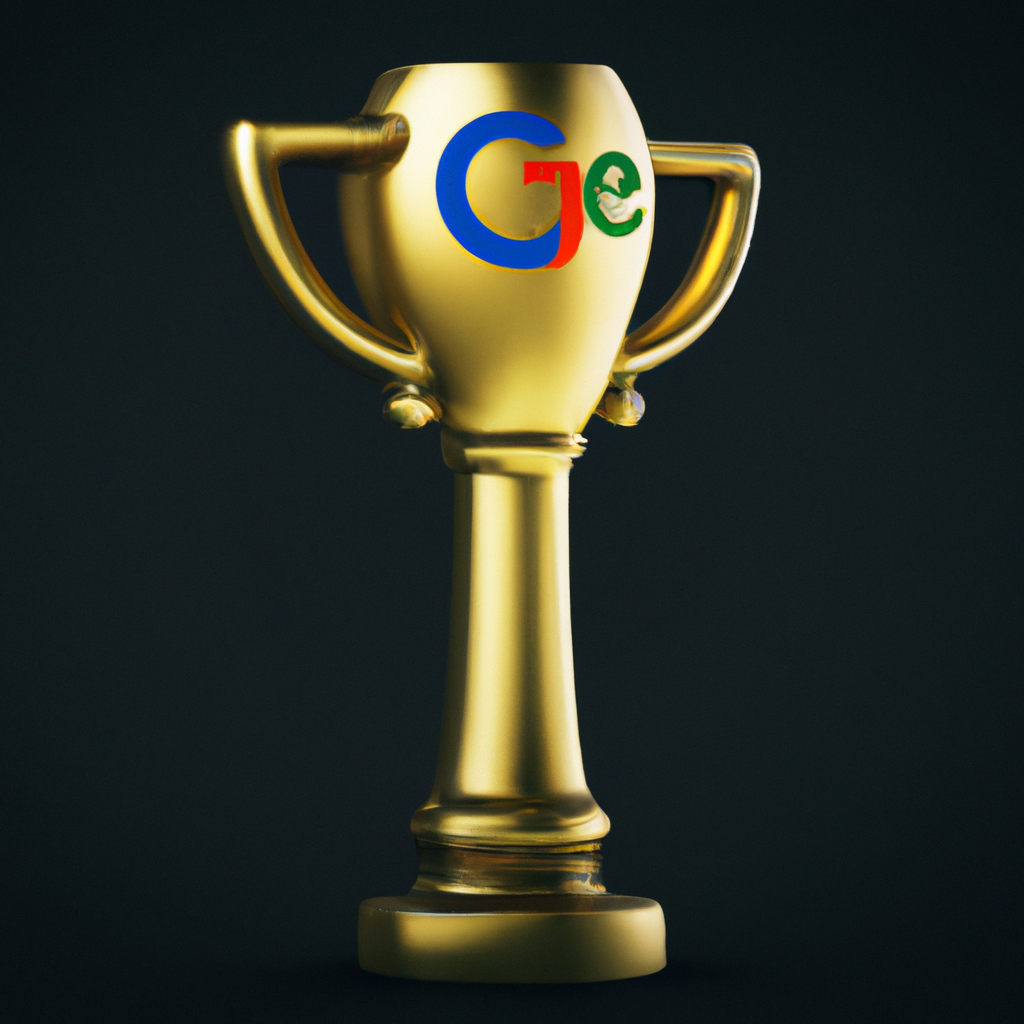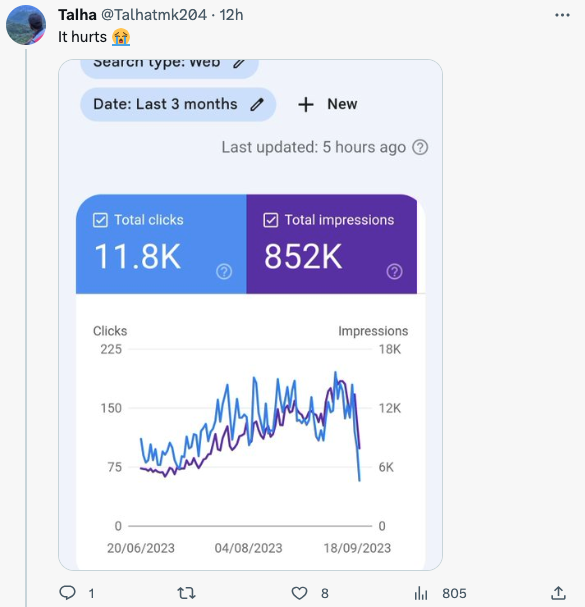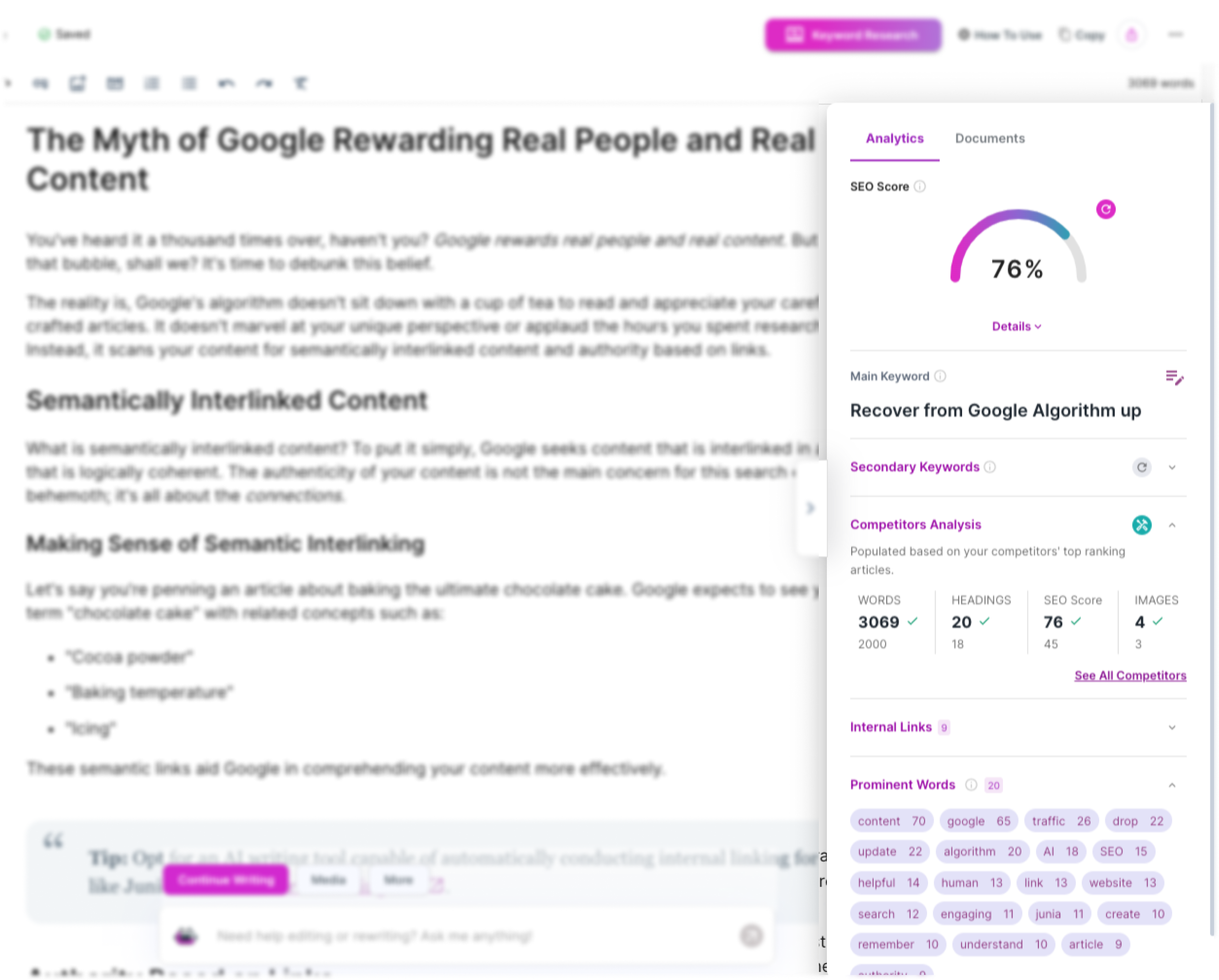
The Impact of Google's Recent Algorithm Update
Just when you thought you had the SEO game figured out, Google rolled out a significant change. Not just any change, but the Google Helpful Content Update. It's like a tornado sweeping through the digital landscape, turning everything upside down. Traffic loss becomes as common as rain in London. But hey, don't pack your bags and abandon ship just yet. There's hope on the horizon. Let's navigate this stormy sea together.
The Google Helpful Content Update has shaken things up, leaving many websites struggling with significant traffic drops. Even those who played by the rules, dotting their i's and crossing their t's found themselves stuck in a quagmire of plummeting site visits. It’s like being a diligent student studying for an exam only to find out the syllabus has changed overnight. Frustrating? You bet.
Exploring the Why on Sudden Traffic Drop

In a startling revelation, uk-based travel writer and editor Elle-Rose reported on Twitter that her website, a product of 12 years of relentless work, suffered an alarming 80% drop in traffic right after Google's recent Algorithm update. This wasn't just a blow to her digital presence; it was a direct hit on her livelihood (The tweet has since been under protection due to an overwhelming surge in responses).
But why is this happening? Well, Google isn't exactly rewarding your stellar content or your painstaking adherence to its guidelines. Sorry to burst your bubble but it’s not about how real or genuine your content is anymore. What Google craves now are semantically interlinked content and authority based on links. Quite a mouthful, isn’t it?
The Silver Lining
Now, before you start thinking of scaling Mount Everest barefoot with spaghetti ropes and meatball anchors (yeah, we've all been there), let me tell you there's a silver lining here.
Recovering from this traffic drop from search engines' algorithm update is more than just possible—it's achievable! And no, it doesn't involve grey hat tactics or shady practices. It involves a shift in strategy—a focus on both search-engine-first and human-first content.
At this point, you might be wondering if such a thing is even possible. Well, guess what? With AI writers like Junia AI that specialize in SEO, it’s more than possible—it’s reality!
The Importance of Recovery From a Google Algorithm Update

So buckle up and get ready to ride this wave. The importance of recovering from this traffic drop is paramount to your website's survival. It's time for a new approach, one where you're not just playing by the rules but rewriting them. Let’s turn this ship around and sail towards brighter horizons!
Understanding the Google Algorithm Update
There's an eleventh commandment in the world of SEO that should be written in stone:
Thou shall stay updated on Google's algorithm changes.
And let's face it, just when you think you've cracked the code, Google rolls out a new update. The latest entrant to this ever-evolving landscape is the Google Helpful Content Update.
What is the Google Helpful Content Update?
In simple terms, this update aims to improve the user experience by prioritizing 'helpful' content. But wait! Isn't all content supposed to be helpful? Well, here's where it gets tricky. Google defines helpful content as information that is not only high quality but also highly relevant and authoritative.
This means that your website needs to have:
- Credible sources
- Relevant information
- High accessibility for both humans and search engine bots.
That's a tall order, right? But remember, at the heart of Google's algorithm lies the end-user and their satisfaction.
At least, that's what Google claims. The truth is, Google doesn't reward real people or genuine content—it never has. This is merely a fabricated white hat trope to placate the industry because Google's algorithm isn't sufficiently sophisticated.
Impact on Website Rankings and Organic Traffic
If your content isn't deemed 'helpful' by Google's new standard, you might find your rankings slipping away faster than sand through fingers. This could potentially lead to a drastic drop in your organic traffic.
Real-world Examples
Let's consider some examples from Twitter. Numerous websites reported severe drops in their organic traffic post this update.

- One such case involved a popular fitness blog that experienced a 40% decline in their organic traffic overnight. They claim to have provided valuable information to users and updated their content regularly, demonstrated E-A-T in their niche, and yet still got hit by Google's recent algorithm update.
- Another instance was an e-commerce site specializing in vintage watches. Despite having a vast collection and detailed product descriptions, they experienced a 30% drop in traffic post-update. Why? They lacked authoritative backlinks to boost their credibility in Google's eyes or is it so?
The Challenge with Google's Ability to Judge Content Quality
In both cases, a common thread was evident - Google doesn't know how to tell if a piece of content is quality or not. But how does Google prioritize ranking helpful content first that truly match users'search intent?
Well, they don't. That's the thing.
A Common Scenario
Have you ever searched for the keyword best mountain bikes and yet ended up with a bunch of articles claiming to list the best mountain bikes? Yet none of these articles are even in the bike niche or even know anything about bikes themselves!
How do they rank then? They rely on backlinks and heavily search-engine optimized articles.
Frustrating for you if you're genuinely interested in purchasing a bike, isn't it?
The Myth of Google Rewarding Real People and Real Content

You've heard it a thousand times over, haven't you? Google rewards real people and real content. But let's pop that bubble, shall we? It's time to debunk this belief.
The reality is, Google's algorithm doesn't sit down with a cup of tea to read and appreciate your carefully crafted articles. It doesn't marvel at your unique perspective or applaud the hours you spent researching. Instead, it scans your content for semantically interlinked content and authority based on links.
Semantically Interlinked Content
What is semantically interlinked content? To put it simply, Google seeks content that is interlinked in a manner that is logically coherent. The authenticity of your content is not the main concern for this search engine behemoth; it's all about the connections.
Making Sense of Semantic Interlinking
Let's say you're penning an article about baking the ultimate chocolate cake. Google expects to see you link the term "chocolate cake" with related concepts such as:
- "Cocoa powder"
- "Baking temperature"
- "Icing"
These semantic links aid Google in comprehending your content more effectively.
Tip: Opt for an AI writing tool capable of automatically conducting internal linking for you, like Junia AI's auto internal linking tool.
Authority Based on Links
Let's delve into the topic of link authority. The question is, does your website have backlinks from high-authority sites? This is akin to receiving approval from the most popular kids in school – it significantly enhances your popularity (or in this context, your site's authority).
Here's a fact: Google adores popular websites! So, no matter how authentic your content may be, if it's devoid of high-quality backlinks, it might as well be invisible to Google.
Interested in learning how to rank without backlinks? Check out this comprehensive guide.
The Frustration of Following Rules

This realization can be frustrating. You've been meticulously adhering to every rule in the book. You've dedicated countless hours to creating engaging, original content that resonates with your audience. In short, you've been doing everything right, yet the rewards seem distant and elusive.
Picture yourself as a chef in this scenario. You've left no stone unturned in mastering every recipe that exists. You've toiled over the stove, honed your craft, and poured your heart and soul into each dish. Your culinary creations are nothing short of masterpieces. And yet, when the time comes for the restaurant critic (let's call this critic Google) to visit, their focus strays from your artistry.
So what catches their attention instead?
Shiny Cutlery Over Culinary Skills?
You'd think they'd be more interested in the exquisite flavors dancing on their taste buds or the visually stunning presentations of your dishes. But alas! What they seem to care about is how shiny your cutlery is or how elegantly your napkins are folded.
This might sound absurd, but it's an apt metaphor for how Google's algorithm works. It's not just about the quality of your content (or in our metaphor, the quality of your cooking), but also about other factors that may seem less important to you.
To continue with our restaurant analogy:
- Link Authority: This would be equivalent to having endorsements from renowned chefs or food critics. Their approval can significantly boost your restaurant's popularity, regardless of how delightful your dishes are.
- Semantic Linking: Imagine this as pairing the right wine with each dish. The connection might not be obvious to a casual diner, but it makes a world of difference for connoisseurs (or search engines).
Remember, it's not that Google is ignoring your content. It's just that they're also paying attention to these other factors. So, the next time you're crafting content, remember to polish that cutlery too!
Is Google's Algorithm Overrated?
In light of these insights, one might argue that Google's algorithm is overrated. If it can't appreciate real content created by real people and lacks the sophistication to understand simple terms, what good is it?
The point here isn't to bash Google or its algorithm. The goal is to help you better understand how it works so you can play the game more effectively.
Instead of focusing solely on creating human-first articles, try shifting your perspective a little. Create search-engine first articles while keeping them engaging and useful for humans too.
Find the balance between satisfying Google's love for semantically interlinked content and link authority while providing valuable content for your readers. This might just be your ticket to recovering from a traffic drop and climbing up those SEO rankings again!
The bottom line is this: The Google Helpful Content Update is shaking up SEO. It's forcing website owners to rethink their strategies, favoring quality over quantity and pleasing the algorithm at the same time. While this update might seem harsh, it just encourages us to do what we've always should've done - create truly helpful content for our users. But we can't forget about search engine optimization. We need to write in a way that Google understands!
Recovering from a Traffic Drop

A traffic drop can be a chilling sight for any website owner. But fret not, it's not the end of the world. The key to bouncing back lies in understanding the root cause and implementing strategic solutions.
1. Recognizing and Diagnosing a Traffic Drop
The first step in countering a traffic drop is identifying that it has occurred. A sudden decrease in organic traffic or a plummeting position on SERPs are telltale signs. Tools like Ahref and Semrush can provide valuable insights into page views, average session duration, bounce rate, and other metrics that indicate your site's health.
Next, diagnosing the cause of the drop is crucial. This process involves looking into the possibility of recent Google updates or algorithm changes impacting your site's performance.
2. Potential Causes for the Drop
Several factors could contribute to a traffic drop; a significant one being Google updates. Changes in algorithms can affect how Google perceives and ranks your content. If your previously high-ranking content no longer aligns with Google's updated parameters, you may witness a dip in traffic.
Keyword stuffing, once a common SEO practice, is now frowned upon by Google. If your content is laden with keywords but lacks substantive value, this could be another reason for your traffic woes.
Sometimes, content could be too advanced for both users and Google's algorithms to comprehend fully. With increasing emphasis on user experience (UX), creating content that resonates with users needs to be prioritized over overly technical jargon-filled pieces.
In such scenarios, it's essential to shift focus towards generating search-engine first articles while ensuring they remain comprehensible and engaging for humans.
3. Strategies for Recovery From the Traffic Loss
Once you've identified potential problems causing the drop, it's time to strategize your recovery plan.
1. Optimizing Existing Content
Start by refining your existing content to meet Google’s current expectations. Ensure that your posts are information-rich, relevant, and add value to the reader. It's also a good idea to revisit your keyword strategy and ensure it aligns with your audience's search intent.
2. Building High-Quality Backlinks
Backlinks are a crucial factor in improving website authority. High-quality, authoritative backlinks can significantly enhance your site's credibility in Google's eyes, helping recover lost traffic.
3. Building a Topic Cluster To Gain Search Engine's Trust
A compelling strategy to regain the trust of search engines (like our friend Google) is by creating a 'Topic Cluster.' Now, you might be wondering - what exactly is a topic cluster? Well, let's dive in!
A topic cluster is essentially a group of interlinked web pages. They're centered around a main "pillar" page that acts as the primary hub of content for an overarching topic and multiple related subtopics. This model allows page authority to flow throughout the site, thereby improving the ranking potential for each individual page. It's like having an intricate web where each strand supports and adds strength to the others.
Now, how can you build an effective topic cluster? Here are some steps to guide you:
- Identify Your Pillar Content: Decide on a broad topic that is central to your brand or business. This will serve as your pillar content. Ideally, this should be a comprehensive guide that provides valuable information on a specific subject that your audience cares about.
- Create Cluster Content: Once you have defined your pillar content, create related subtopic content. These should be in-depth pieces addressing various aspects of your main topic (pillar), thereby adding value and depth to the overall content.
- Use Internal Linking: The magic ingredient in this recipe! Link all of your cluster pages back to the pillar page using hyperlinks with relevant anchor text. This creates a network of interconnected pages that add value for users and search engines alike.
By building an effective topic cluster, you're not only boosting your SEO efforts but also providing your audience with high-quality, organized content — who wouldn't appreciate that? This approach helps indicate to search engines that you're an authority in your field, which could help recover any lost traffic and improve overall website performance.
Remember, building a topic cluster isn't just about gaining search engine trust, it's about providing your audience with the best user experience possible. After all, isn't that what we're all striving for?
4. Focusing on User Experience and Engaging Content
Enhancing user experience should be at the forefront of your recovery strategy. Ensure that your site is easy to navigate, mobile-friendly, and delivers engaging content that keeps visitors coming back for more.
5. Changing Your Target Keyword
Sometimes, despite all your best endeavors (and trust me, we've all been there), nothing seems to work. You might find yourself stuck in a situation where Google, that mighty search engine behemoth, just can't seem to recognize the true quality of your content for your chosen target keyword.
Does this mean you've failed? Absolutely not! It simply suggests that it's time to reconsider or tweak your strategy. Perhaps it's time to switch gears and look for a new target keyword.
4. Leverage AI Writers for Search-Engine First Content
Writing SEO-optimized content while keeping it engaging for humans can be challenging. That's where AI writers made for SEO like Junia AI come into play. Junia AI specializes in creating long-form content optimized for search engines, yet still enjoyable for human readers.
By leveraging Junia AI, you get access to an innovative solution that understands Google’s expectations while keeping human engagement in mind. It offers a balance between SEO-rich content and user-friendly articles - the perfect recipe for recovering from a traffic drop due to an algorithm update like Google's!
Remember, every setback is an opportunity for a comeback. With strategic planning and the right tools like Junia AI at your disposal, recovering from a traffic drop can be a stepping stone towards achieving higher rankings than ever before!
Balancing SEO and User-Focused Content

Let's plunge headfirst into this: the golden rule of content creation is to serve two masters - Google's complex algorithms and your human readers.
The Importance of Dual-Focused Content
Remember that Google can't detect if your content is helpful or not. It uses complex algorithms to analyze your website and determine its relevance to search queries. But simultaneously, it doesn't have a human brain to understand the depth or quality of your content fully. Don't let this dishearten you, though. It's a challenge, yes, but not an insurmountable one.
Contrarily, your human audience, they cherish value. They want problem-solving insights, engaging narratives, and a palatable presentation. They don't care about keywords or meta tags - they want to be informed, entertained, or helped. And if you can provide that along with a sprinkle of personality and authenticity? You've got them hooked.
Using AI for a Balanced Approach
Treading the thin line between SEO-focused content and user-focused material might sound like navigating through a minefield in pitch darkness. Enter AI writers specialized in SEO - a beacon in the murky waters of content creation. You see, these cutting-edge tools like Junia AI can help strike the perfect balance.
How do they perform this magic? By weaving in keywords seamlessly without compromising readability. By structuring content that pleases both Google bots and human brains. By ensuring all technical SEO aspects are covered while keeping the narrative engaging. They're like skilled jugglers handling chainsaws and roses at once - with finesse and without any mishaps.
Creating Dual-Satisfying Content: A Few Quick Tips
Now let's dive into some actionable snippets on creating content that satisfies Google’s algorithms while delighting your readers:
- User Intent: Identify why users would search for your focus keyword(s). What information are they seeking? Aim to answer their queries in a comprehensive, user-friendly manner.
- Keyword Usage: Use your primary and secondary keywords naturally throughout the content. They should blend into the narrative organically without disrupting the flow.
- Engagement: Incorporate engaging elements such as stories, questions, and relatable examples. Keep your language conversational and authentic.
- Formatting: Break up your content into digestible chunks using headings, subheadings, bullet points, and images. This improves readability for users and helps Google bots understand your content.
- Linking: Incorporate internal and high-quality external links to boost SEO while providing additional value to your readers.
Keeping Google's Understanding in Mind
When crafting content, it's important to remember that Google's understanding is not as nuanced as a human's. For instance, it might not grasp the connotations of certain words or comprehend complex metaphors fully.
So always ask yourself:
- "Does Google understand this word?"
- "Does Google answer this sentence?"
- "Does Google understand this is a rhetorical question or a metaphor?"
Remember, our goal is a harmonious dance between search engine-first and human-first content. It's not easy; it's an art of balance, requiring constant learning and adaptation. But with the right tools (yes, we're looking at you Junia AI) and strategies, it certainly isn't an impossible feat.
Conclusion
We've certainly covered a lot of ground! From deciphering the enigma that is Google's Helpful Content Update, to unmasking the half-truths surrounding Google's supposed favoritism towards 'real' content. We've also plunged headfirst into the icy waters of traffic drops, surfacing with actionable insights on how to bounce back.
Adapting to Google's Algorithm Changes
Remember, Google's algorithm updates might feel like a cruel game of Whack-a-Mole, but they're not insurmountable. Adaptability is your trusty compass in this ever-changing landscape. It's about learning to dance in the rain while everyone else is waiting for the storm to pass. SEO isn't just about playing according to Google's sheet music - it's about composing your own symphony of value that resonates with both search engines and users.
The Collective Struggle and Opportunity for Growth
Let's not forget that we're all in this together! Every webmaster and content creator out there has felt the sting of a sudden traffic drop at least once. It's like a rite of passage in the digital realm. But rather than wallowing in despair, let's turn these challenges into opportunities for growth.
Keep creating! Keep optimizing! Keep providing value! The road to recovery may be steep, but every step counts. It might be tempting to throw in the towel when your meticulously crafted content doesn't get the recognition it deserves. But remember, Rome wasn't built in a day. Neither are high-ranking websites or esteemed online authority.
Introducing Junia AI: Your #1 SEO Writing tool
Now, let's talk about making your life easier. Imagine having a secret weapon in your arsenal - a tool that understands SEO as well as you do (or perhaps even better!). A tool that can weave engaging narratives while sprinkling just the right amount of SEO magic to appease both humans and algorithms.
That's where Junia AI steps in. It's not just another AI writer; it's an AI writing tool specifically designed for SEO, helping to recover from updates to Google's algorithm like this one. Think of it more as your personal SEO wizard, conjuring up content that's optimized for search engines yet still engaging for your human readers. From long-form blog posts to intriguing social media snippets, Junia AI has got you covered.
So why wait? Start your journey towards recovery from traffic drops today with Junia AI. Let's outsmart Google's updates together and keep soaring higher in the SERPs! Remember, every cloud has a silver lining - and yours could be an AI-powered boost to your SEO game.
